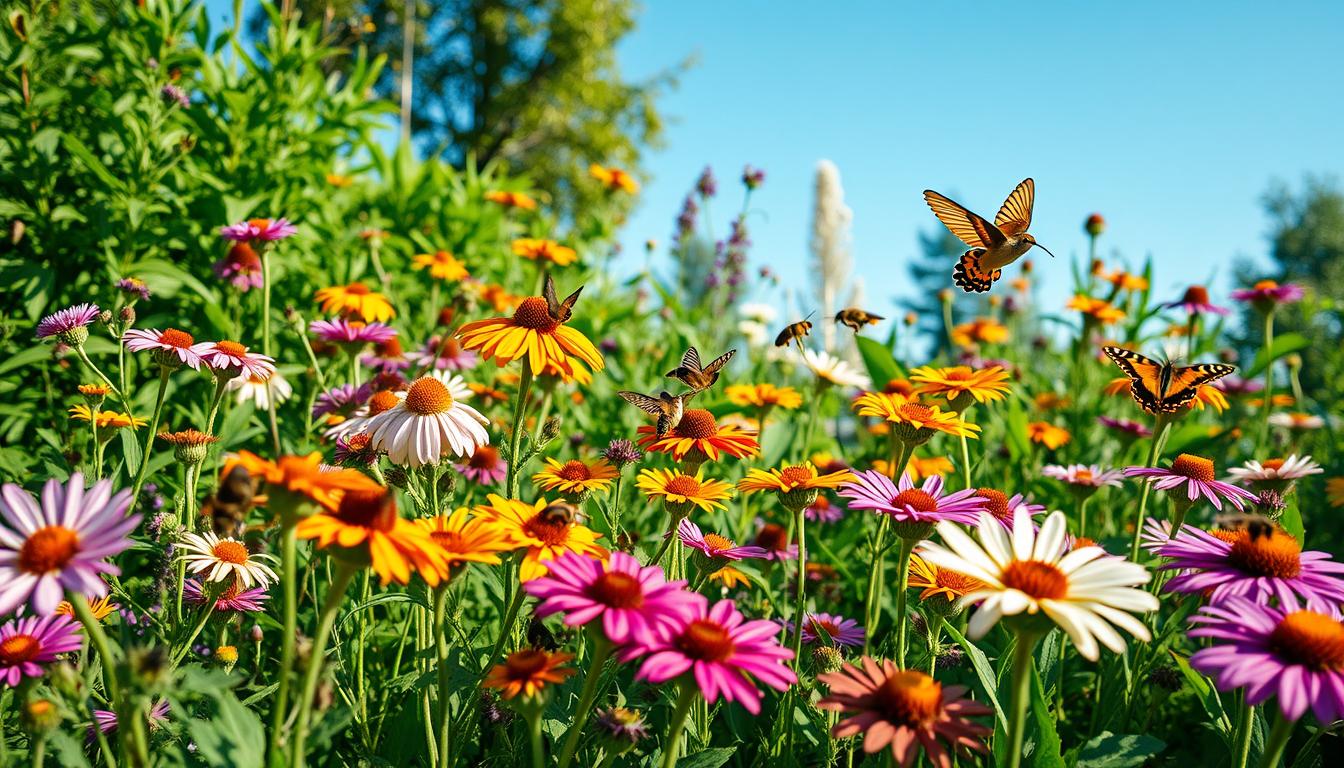I’m excited to share my journey into the world of pollinator gardens! These special green spaces have become my passion. I’m eager to tell you why they’re so important.
Creating a pollinator garden brings joy to both nature and myself. Watching bees, butterflies, and birds is amazing. These gardens help maintain biodiversity and ensure our food supply.
In this guide, I’ll share everything I’ve learned about pollinator gardens. From choosing the right plants to attracting diverse pollinators, I’ll give you tips. Let’s explore how these gardens can impact our environment and add beauty to our lives!
What are Pollinator Gardens and Why They Matter
Pollinator gardens are a great way to help urban biodiversity and improve ecosystem services. They are special gardens that attract and feed bees, butterflies, birds, and other pollinators. These gardens are important for our environment.
Definition of Pollinator Gardens
A pollinator garden is a space with flowers and plants that give food and shelter to pollinators. They can be small, like a balcony, or big, like a backyard. This makes them easy for anyone to help pollinators.
Importance of Pollinators
Pollinators are key for healthy ecosystems and food production. They move pollen between flowers, helping plants make fruit and seeds. In cities, pollinator gardens help local plants and animals thrive.
Types of Pollinators
There are many pollinators, each with its own role in urban biodiversity:
- Bees: Including honeybees and native bees
- Butterflies and moths
- Hummingbirds
- Bats
- Flies and beetles
| Pollinator | Preferred Flowers | Active Season |
|---|---|---|
| Bees | Lavender, Sunflowers | Spring to Fall |
| Butterflies | Milkweed, Zinnia | Spring to Fall |
| Hummingbirds | Trumpet Honeysuckle, Cardinal Flower | Spring to Fall |
Creating a pollinator garden helps these vital creatures and boosts my local ecosystem’s health. It’s a fulfilling way to support urban biodiversity and enjoy nature in my backyard.
Personal Benefits of Creating a Pollinator Garden
Creating a pollinator garden has brought me joy and fulfillment. It supports conservation and offers personal rewards. Let’s explore the benefits I’ve experienced firsthand.
Enhancing My Outdoor Space
My pollinator garden turned my yard into a vibrant oasis. The colorful flowers and buzzing activity make it lively. It’s now a focal point, admired by neighbors and passersby.
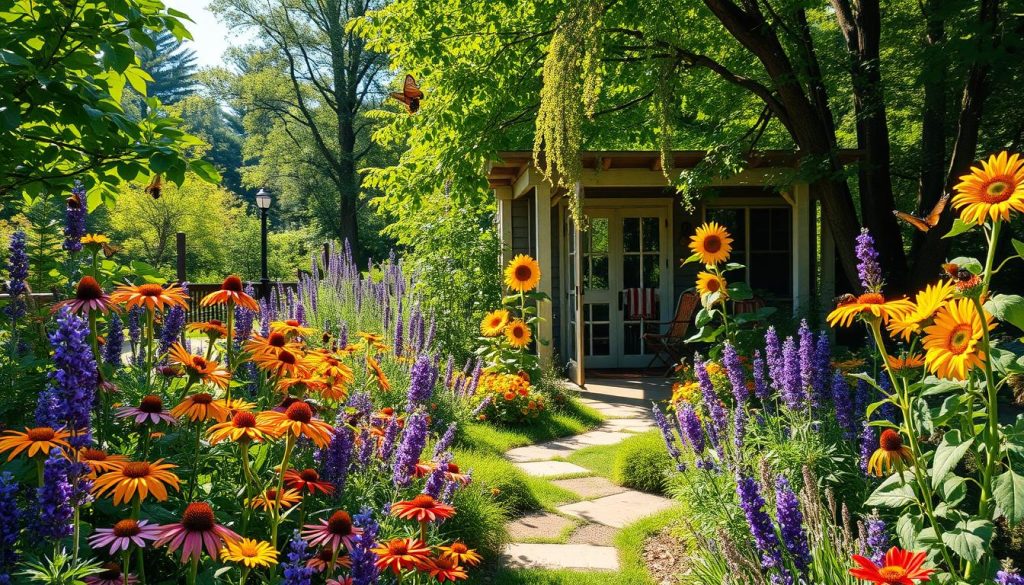
Enjoying Nature’s Beauty
Watching butterflies dance from bloom to bloom fills me with wonder. Hummingbirds dart between flowers, their wings a blur of motion. These magical moments connect me to nature’s rhythms and beauty right in my backyard.
Gardening as a Therapeutic Activity
Tending to my pollinator garden soothes my mind and rejuvenates my spirit. The act of planting, weeding, and nurturing plants reduces stress and improves my mood. It’s a form of mindfulness that grounds me in the present moment.
| Benefit | Impact on Well-being |
|---|---|
| Stress Reduction | Lowers cortisol levels |
| Physical Activity | Improves cardiovascular health |
| Connection to Nature | Boosts mood and mental clarity |
| Sense of Purpose | Increases feelings of fulfillment |
By creating a pollinator garden, I’ve found a rewarding hobby. It aligns with my values of conservation and sustainable gardening. It’s a win-win situation – I enjoy a beautiful, therapeutic space while supporting local ecosystems.
Environmental Benefits of Pollinator Gardens
Pollinator gardens are more than just a pretty sight in my backyard. They play a key role in protecting our environment. These gardens are powerhouses for promoting biodiversity and supporting ecosystem health.
Promoting Biodiversity
By planting native plants, I create a haven for local wildlife. These plants provide food and shelter for various species, from bees to butterflies. My garden becomes a mini-ecosystem, supporting a diverse range of creatures.
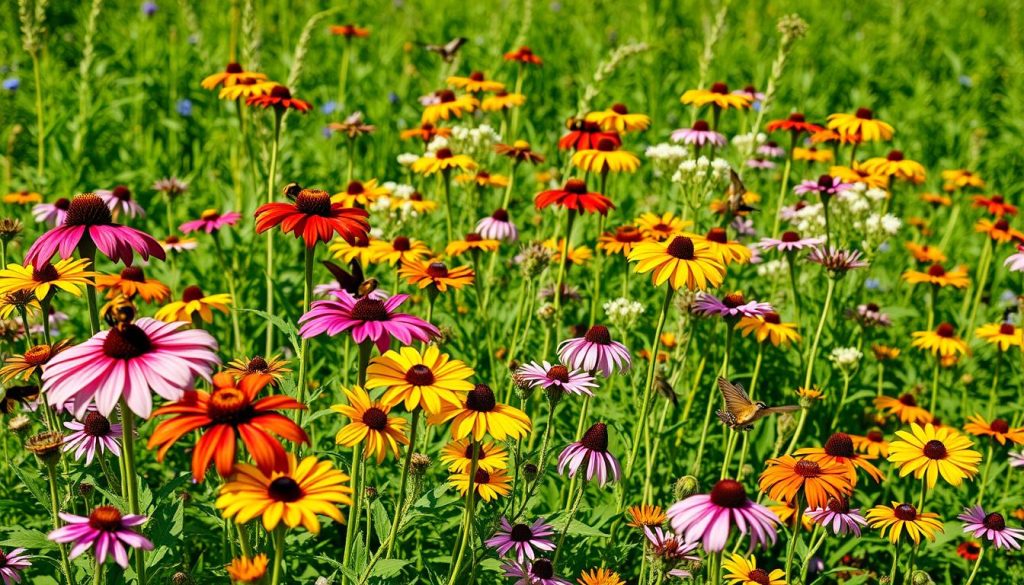
Supporting Ecosystem Health
Pollinator gardens contribute to habitat restoration. As I add more native plants, I help rebuild natural habitats lost to development. This restoration is vital for maintaining healthy ecosystems and ensuring the survival of native species.
Combating Climate Change
Surprisingly, my pollinator garden helps fight climate change. Native plants are often deep-rooted, which helps sequester carbon in the soil. They’re also more resilient to changing weather patterns, making them a smart choice for a changing climate.
| Environmental Benefit | Impact |
|---|---|
| Biodiversity | Increases variety of plant and animal species |
| Habitat Restoration | Rebuilds natural ecosystems |
| Climate Change Mitigation | Enhances carbon sequestration |
By creating a pollinator garden, I’m not just beautifying my yard. I’m taking an active role in preserving our environment and supporting the delicate balance of nature. It’s a small step that makes a big difference.
Choosing the Right Plants for My Garden
Creating bee-friendly landscapes is key for environmental stewardship. I’ve found that picking the right plants is essential for a pollinator garden to thrive. Let’s look at the best plants to attract these helpful creatures to my yard.
Native Plants vs. Non-Native Plants
Native plants are usually the best for my garden. They fit local conditions and feed native pollinators. Non-native plants may look nice, but they might not support local wildlife as well. I aim to use at least 70% native plants to make my garden truly bee-friendly.
Top Flowering Plants for Pollinators
I’ve found some great flowering plants that pollinators love:
- Coneflowers
- Black-eyed Susans
- Bee balm
- Milkweed
- Lavender
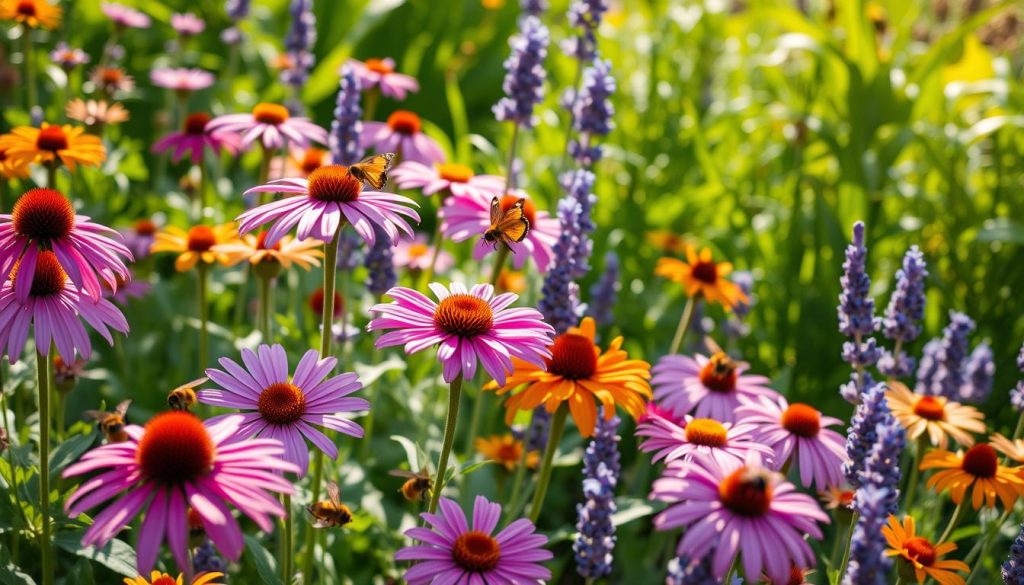
Planting for Different Seasons
To practice good environmental stewardship, I plan my garden to bloom all year. This way, pollinators have food sources in every season. Here’s a simple guide I follow:
| Season | Plants |
|---|---|
| Spring | Crocus, Bluebells, Lilac |
| Summer | Sunflowers, Zinnias, Cosmos |
| Fall | Asters, Goldenrod, Sedum |
| Winter | Winter Jasmine, Witch Hazel, Hellebores |
By choosing a mix of these plants, I can create a vibrant, bee-friendly landscape. This supports pollinators all year long. It’s a rewarding way to contribute to environmental stewardship in my own backyard.
Designing My Pollinator Garden
I’m excited to share my journey of designing a pollinator garden. This process not only enhances my outdoor space but also contributes to urban biodiversity. Let’s dive into the key aspects of creating a thriving habitat for pollinators.
Layout Considerations
When planning my garden layout, I focus on plant groupings and diversity. I create clusters of the same plant species to attract pollinators and make nectar collection easier. I also mix different plant heights and bloom times to provide a varied and long-lasting food source.
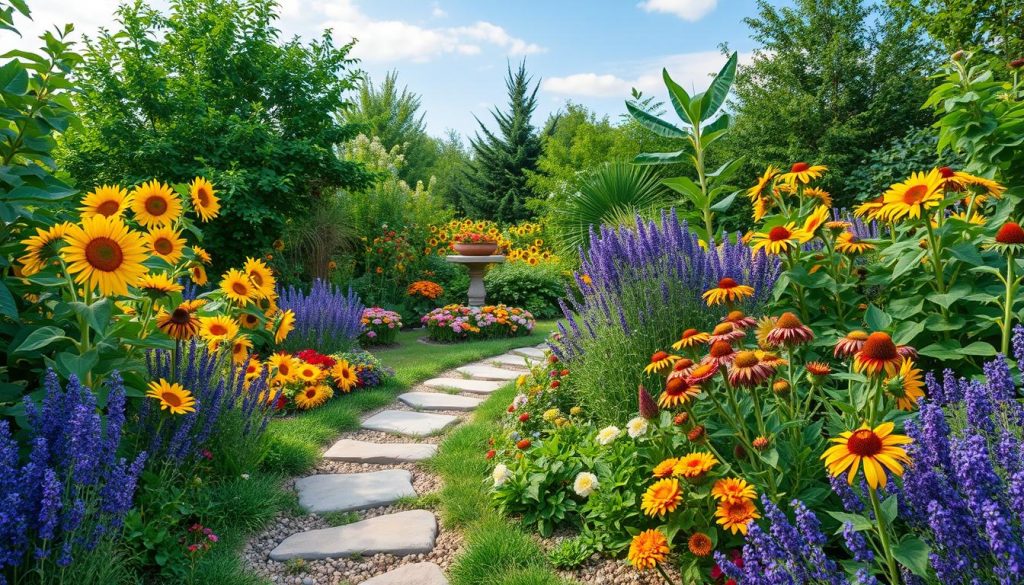
Selecting the Right Location
Choosing the perfect spot is crucial for the success of my pollinator garden. I consider factors like sunlight exposure, soil type, and water availability. Most pollinator-friendly plants prefer full sun, so I aim for areas that receive at least six hours of direct sunlight daily.
Creating Microhabitats
To maximize the benefits of pollinator gardens, I incorporate various microhabitats. These small ecosystems support different pollinator species and increase urban biodiversity. I include features like:
- Rock piles for solitary bees
- Bare soil patches for ground-nesting bees
- Shallow water sources for butterflies
- Dead wood for beetle larvae
By thoughtfully designing my pollinator garden, I create a welcoming space for diverse pollinators and contribute to the overall health of my local ecosystem.
| Garden Feature | Purpose | Pollinator Benefited |
|---|---|---|
| Native flowering plants | Provide nectar and pollen | Bees, butterflies, hummingbirds |
| Herb garden | Attract pollinators, culinary use | Bees, butterflies |
| Birdbath | Water source | Butterflies, bees |
| Bee hotel | Nesting site | Solitary bees |
Attracting Pollinators to My Garden
Creating a garden that welcomes pollinators is a great way to help them. It’s not just about planting flowers. Let’s look at some ways to make my garden a safe haven for these tiny helpers.
Types of Insects to Attract
I aim to attract different pollinators to my garden. Bees, butterflies, and hoverflies are my main focus. Each one is important for pollination, keeping my garden healthy.
| Pollinator | Role | Preferred Plants |
|---|---|---|
| Bees | Excellent pollinators for most flowers | Lavender, Sunflowers, Coneflowers |
| Butterflies | Long-distance pollen transfer | Milkweed, Zinnia, Marigolds |
| Hoverflies | Pollination and pest control | Dill, Fennel, Cosmos |
Creating Water Sources
Pollinators need water, just like we do! I’ve placed shallow water dishes with pebbles for them to land on. This simple step has made my garden more welcoming to thirsty visitors, boosting their pollination work.
Avoiding Pesticides
To keep my pollinator friends safe, I’ve stopped using harmful pesticides. Instead, I use natural ways to control pests, like companion planting and picking them by hand. This keeps my garden balanced, letting pollinators do their important work.
Maintaining My Pollinator Garden
Keeping my pollinator garden healthy is crucial for sustainable gardening and conservation. Regular care is essential to attract pollinators.
Regular Garden Care Tips
I water my plants deeply but not too often to help their roots grow strong. Mulching keeps the soil moist and weeds away. Pruning dead flowers encourages new blooms, attracting more pollinators.
Seasonal Tasks to Consider
Each season requires different tasks for my pollinator garden:
- Spring: Clean up winter debris and plant new flowers
- Summer: Water deeply during dry spells
- Fall: Leave some plant stalks for winter insect homes
- Winter: Plan next year’s garden layout
Monitoring Pollinator Activity
Watching my garden come alive is a joy. I keep a log of pollinator visits to see how my garden is doing. This helps me know which plants are most popular and plan for next year.
| Season | Common Pollinators | Favorite Plants |
|---|---|---|
| Spring | Bumblebees, Mason Bees | Crocus, Bluebells |
| Summer | Butterflies, Hummingbirds | Coneflowers, Bee Balm |
| Fall | Honeybees, Monarchs | Asters, Goldenrod |
By caring for my pollinator garden, I’m doing more than just beautifying my space. I’m supporting biodiversity and helping with conservation efforts right in my backyard.
Educational Opportunities with Pollinator Gardens
Pollinator gardens are great for learning and growing. They’re perfect for teaching about nature and bringing people together. These gardens can spark a love for environmental stewardship in both kids and adults.
Teaching Kids About Ecology
I love using my pollinator garden to teach kids about ecology. It’s like a living classroom! We explore the different plants, watch bees and butterflies at work, and learn how everything connects. It’s hands-on learning that really sticks.
Engaging with the Community
My pollinator garden has become a community hub. I invite neighbors to help plant and maintain it. We share seeds, swap gardening tips, and talk about local habitat restoration efforts. It’s a great way to build connections and spread awareness.
Hosting Workshops and Events
I’ve started hosting small workshops in my garden. We cover topics like:
- Creating pollinator-friendly spaces
- Identifying local pollinators
- Sustainable gardening practices
- The importance of native plants
These events are fun and informative. They inspire others to start their own pollinator gardens.
| Event Type | Target Audience | Key Topics |
|---|---|---|
| Kids’ Garden Club | Children 6-12 | Basic ecology, planting seeds |
| Community Planting Day | All ages | Habitat restoration, teamwork |
| Pollinator Photography Workshop | Adults | Wildlife identification, nature photography |
By sharing my pollinator garden, I’m helping spread the word about environmental stewardship. It’s amazing to see how a small space can make such a big difference in education and community engagement.
Overcoming Challenges in Pollinator Gardening
Creating a garden that helps bees can be rewarding but comes with challenges. I’ve faced many obstacles in my journey to keep a pollinator garden thriving. Let’s look at some common problems and how to solve them.
Dealing with Weeds and Pests
Weeds and pests can harm your garden. Mulching helps keep weeds away and keeps the soil moist. For pests, I use natural methods like planting certain plants together and picking off insects by hand. This way, I protect the good pollinators.
Seasonal Changes and Their Impact
Each season brings its own challenges to my garden. In spring, I get ready for new growth. Summer means more watering and fighting pests. Fall is great for planting native plants, and winter is for protecting the garden.
Finding Reliable Resources
To learn about native plants and bee-friendly gardens, I trust certain sources. Local offices, plant societies, and gardens are great for advice. Online, the Pollinator Partnership and the Xerces Society have lots of helpful information.
| Challenge | Solution |
|---|---|
| Weed control | Mulching, hand weeding |
| Pest management | Companion planting, natural predators |
| Seasonal adaptations | Proper planning, plant protection |
| Information gathering | Consult local experts, online databases |
Sharing the Success of My Pollinator Garden
I love watching my pollinator garden grow. Bees, butterflies, and other pollinators visit every day. I keep a journal to track my garden’s progress.
Documenting My Garden’s Progress
Photography helps me record my garden’s journey. I take pictures of new blooms and pollinators. These photos inspire me to improve my garden.
Engaging on Social Media
Sharing my garden on social media is rewarding. I post photos and updates on Instagram and Facebook. It’s great to connect with other gardeners and share tips.
Joining Local Gardening Groups
Joining local gardening groups is beneficial. They organize events and projects for pollinator conservation. I’ve learned a lot and made friends who share my passion.

